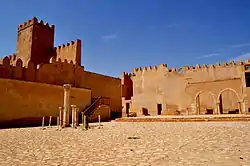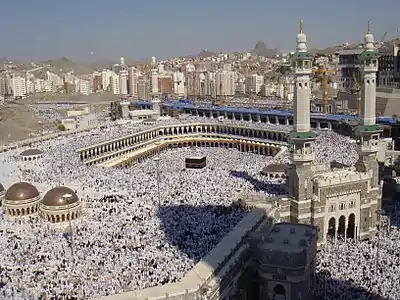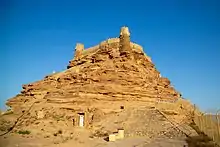Kasbah
A kasbah (/ˈkæzbɑː/, also US: /ˈkɑːz-/; Arabic: قَـصَـبَـة, romanized: qaṣabah, Arabic pronunciation: [qasˤabah], "central part of a town or citadel"), or variant spelling casbah or qasbah in English, also known as qasaba, gasaba and quasabeh, in India qassabah, in Portuguese alcáçova, and in Spain alcazaba, is a type of medina or fortress (citadel).[1][2][3] The meaning of the word kasbah is varied, including "keep", "old city" and "watchtower" or "blockhouse".
Keep
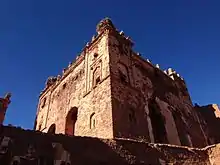
In the Maghreb and in Iberia, the Arabic word form of kasbah frequently refers to multiple buildings in a keep, a citadel, or several structures behind a defensive wall. The Spanish word alcazaba is a cognate naming the equivalent building in Andalusia or Moorish Spain. In Portuguese, it evolved into the word alcáçova. In Catalan, the evolution resulted in alcassaba. A kasbah was a place for the local leader to live and a defense when a city was under attack. A kasbah has high walls, usually without windows. Sometimes, like in Tangiers, they were built on hilltops so that they could be more easily defended. Some were placed near the entrance to harbors. Having a kasbah built was a sign of wealth of some families in the city. When colonization started in 1830, in northern Algeria, there were a number of kasbahs that lasted for more than 100 years.
Old city
The word kasbah may also be used to describe the old part of a city, in which case it has the same meaning as a medina quarter. Some of the prominent examples of kasbah as an old city is the Casbah of Algiers and the Casbah of Dellys. In Turkish and Urdu the word kasaba refers to a settlement larger than a village but smaller than a city; in short, a town. In Serbo-Croatian, kasaba (Cyrillic: касаба) means an undeveloped, provincial small town. In India, a qasbah is a small town distinguished by the presence of Muslim families of rank.[4]
Watchtower
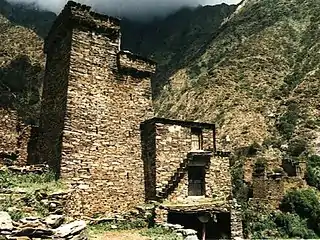
In Al-Bahah and Asir provinces of Saudi Arabia and in Yemen, the word "qasaba" usually refers to a single stone or rock tower, either as part of a tower house or a tower isolated on a hilltop or commanding a field. The Encyclopædia Britannica defines it as: "Ancient qasaba ("towers") found in the province were used as lookouts or granaries."[5] Another book describes these towers as follows: "Apparently unique to Asir architecture are the qasaba towers. Controversy surrounds their function - some argue that they were built as lookouts, and others that they were keeps, or even granaries. Perhaps it is a combination, although the right position of a watchtower, on a hill top, is the wrong place for a keep or granary."[6] Archeologists have found images of similar towers in the ruins of Qaryat al-Fāw, in the Rub' al-Khali or the Empty Quarter of Saudi Arabia, that date from between the third century BCE to the 4th century or our era. "Homes rose two stories, supported by stone walls nearly two meters (6') thick and boasting such amenities as water-supply systems and second-floor latrines. One eye-catching mural faintly depicts a multi-story tower house with figures in the windows: Its design resembles similar dwellings today in Yemen and southern Saudi Arabia."[7] "Most of the qasabas have a circular plan, although some are square. Sometimes they have a band of quartz stones just below the windows or framing the windows- one well preserved examples is at the top of Wadi Ain. The remains of a martello tower-like stone structure are just off the dirt track north of Al-Masnah. It appears to be an interesting antecedent of the Asir farmhouse and perhaps closely related to the qasaba. It is in ruins now, but was once a dwelling and is strongly defensive."[6] One account says about a traditional village in Al-Bahah, Saudi Arabia: "Even the road that leads to the village is impressive, and several historical stone and slate towers dot the way. Al-Bahah Province is known as the region of 1001 towers, once built to protect villages, roads and plantations from rivalling tribes. Today, these towers are abandoned, and many of them are partially or completely in ruins."[8]
References
- Morocco Baedeker Guide -Ingeborg Lehmann, Rita Henss – 2012 Page 214 "KASBAH A mud-brick castle that serves as a residence for the local Berber tribe is called a kasbah or »tighremt« in Morocco. Some are private mansions, others are even whole fortified villages with many large and small buildings crowded on ..."
- Marrakesh Fez Rabat Barnaby Rogerson – 2000– Page 65 "as its purpose, for a kasbah should be the domain of a ruler, be he sultan, governor or just a tribal chieftain. Most of the ancient cities of Morocco retain a large portion of their outer walls, but the kasbah (the government citadel containing ... "
- Morocco – A Country Study Guide Usa Ibp, International Business Publications, USA. – 2006 Page 229 "Sultan Abdelmoumen transformed what was not much more than a Casbah and built a mosque and a palace here too."
- Boundaries and identities: Muslims, work and status in Aligarh E. A. Mann – 1992 p. 23 " "A qasbah is a small town distinguished by the presence of 'decent people or families of some rank' (Platts, 1974). ."
- The New Encyclopædia Britannica. 1998. "Asir." 15th edition. Volume 1, "Micropedia". Page 635.
- Mostyn, Trevor. 1983. Saudi Arabia- A MEED Practical Guide. London: Middle East Economic Digest. 2nd edition. Page 320.
- Covington, Richard. 2011. "Roads of Arabia." Saudi Aramco World. March/April 2011. Pages 24-35.
- "Marble Village of Dhee Ayn."
External links
- "Old stone towers in Asir village - Saudi Arabia."
- "Tower in Rijal Alma village - Saudi Arabia."
- "Marble Village of Dhee Ayn."
- "Images from Saudi Arabia – Rock House Sealed with Mud – Ancient Watch Tower."
- Wiktionary "kasaba"
| Wikimedia Commons has media related to Kasbahs. |
